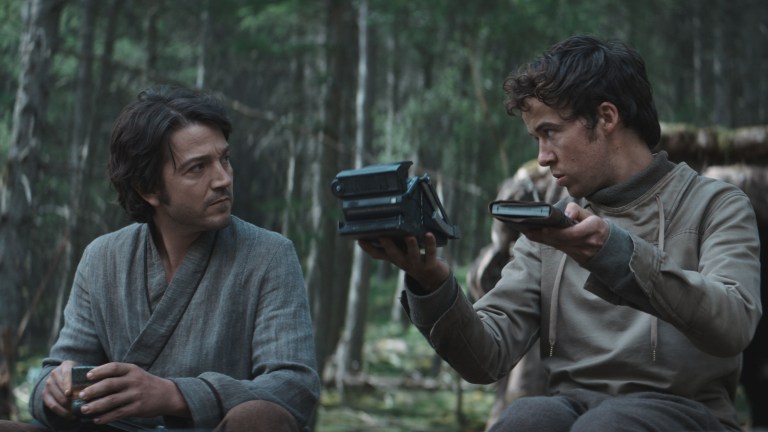Andor’s Release Schedule Was Clearly a Huge Mistake
Should Andor season 1 have just released as four Star Wars TV movies?

This Star Wars: Andor article contains spoilers.
Five episodes in, it’s clear that Andor is following a very specific pattern to tell its story. The first season is broken up into four arcs of three episodes each. The first episode of each arc introduces the setting, characters, and Cassian Andor‘s new objective, while the second slows things down to a crawl to heighten the drama and flesh out each character. The third part is presumably the one where things actually happen — it’s the one you’ve been waiting for all along.
The problem is that this means two-thirds of Andor‘s episodes so far just feel like a waiting game. Sit through this episode where nothing happens except Cassian rents a transport, Syril rides a ship, and Luthen takes a bus because you know the next one’s going to be the banger. Watch the rebels on Aldhani wake up, go back to bed, and wake up again to go on a hike — all while Syril eats cereal at his mom’s house and Deedra pops aspirin — because remember that heist we mentioned two weeks ago? It’s finally happening next week. Hopefully.
It’s important to note that this three-episode, four arc structure was an intentional creative choice. Showrunner Tony Gilroy, who also helmed extensive reshoots on Rogue One a few years ago, said as much in interviews ahead of the show’s premiere in September.
“Directors work in blocks of three episodes, so we did four blocks [in Season 1] of three episodes each,” Gilroy told Empire, while elaborating on the structure in an interview with Mashable, saying, “We essentially made four new Star Wars films. And we’re gonna make four more.”
He’s also said the slower-paced series is meant to feel a bit like a novel. He told Mashable that the show “endeavors to be a 1,500-page novel by the time it’s done…It really is Dickensian. Multiple characters, multiple plots, multiple intrigues; everybody’s adventure stories colliding with one another. The idea is to start extremely small, and we are going to get huge.” And to Total Film, he described the upcoming Andor season 2 as “the second half of the novel.”
As our own critic has already pointed out, Andor has from the very beginning taken a more literary approach than what we’ve usually come to expect from Star Wars fare on Disney+ or on the big screen. It takes its time to set a scene and raise the tension, is delightfully obsessive about details and worldbuilding, and values its characters and themes over shallow easter eggs and fan service every step of the way, which is incredibly refreshing for the nostalgia-obsessed franchise. But, at least for this writer, it does these things while also sacrificing one of the basic tenets of episodic television: that it should have to entertain its audience from one installment to the next. Andor‘s need to feel like a movie or novel while still following the release schedule of an episodic television show has simply done it no favors.
Now, there’s nothing inherently wrong with the three-act structure of a movie or novel, but if Andor‘s arcs are meant to emulate films, why was this story released as a weekly episodic TV series at all? If two of three episodes per arc are just meant to set up the thing that actually happens in the third, wouldn’t it have made more narrative sense to release each arc as a whole to be watched as a more cohesive TV movie? The way Andor episodes are paced and cut certainly suggests this.
Take episodes 4 and 5, for example, which don’t feel like they resolve in any real way; you couldn’t even call these abrupt stopping points cliffhangers meant to bring the narrative tension to a peak. Both episodes conclude on conversations that just kind of end as the credits roll, like someone walked into the theater midway through the play and turned off the lights. “That’s it, see you next week.” (In the case of “The Axe Forgets,” Luthen literally shuts the lights of his showroom and walks off stage to mark the completely arbitrary end of the episode.) In both cases, it’s an odd way to close an hour of television, never ending on an exciting point in the story, but feeling more like you’ve stuck the bookmark back in your book because it’s late and you’ve grown too sleepy to keep on reading.
In all fairness to Andor, this is hardly an isolated incident. The Star Wars series is just the latest in a growing trend of streaming shows that strive to feel more like “multi-part movies” where all the big plot beats happen in the back half of the story instead of throughout the season. Stranger Things 4 Vol. 1 is seven episodes of setup and filler, followed by two massive episodes in Vol. 2 containing all the important moments of the season. The Lord of the Rings: The Rings of Power has arguably waited six episodes to actually kickstart its story, with pretty visuals and worldbuilding often standing in for plot. Much closer to home, virtually nothing of note happened in the present-day storyline of The Book of Boba Fett until the Mandalorian and Grogu showed up midway through the season.
Vox critic-at-large Emily St. James said it best a few weeks ago on Twitter: “Too many TV shows right now are shows where things are perpetually about to happen.”
That’s exactly how it feels to watch the first two episodes of an Andor arc. You’re watching them because you’ve been promised that something is going to happen…eventually. The show, and arguably Disney+ as a whole, has adopted strategies that made Netflix a streaming TV powerhouse in the last decade, but in starkly different packaging that doesn’t really complement the “TV series as a multi-part movie” approach. Netflix shows largely follow a binge model that doesn’t require you to wait a week at a time for the next part of the story, which is usually structured in a way that entices you to keep watching, even if it’s just to see if anything of note does eventually take place. With a Netflix series, even if episode 4 was a plodding filler episode that didn’t push the story forward as much as you hoped, episode 5 is just a click of a button away. In other words, it’s easier to accept the blurring of the line between something episodic in a traditional sense and just a very long movie broken up by credits sequences on Netflix.
But Disney+ streams new episodes of its series on a strictly weekly basis. There are certain expectations that come with that release schedule, and they’re not even novel ones, since cable was doing episodic television long before streaming was ever even a thing. Don’t get me wrong, I’m not saying every episode of Andor needs to have a big action sequence to be successful (although I’m of the opinion that memorable action scenes are a key part of what makes Star Wars great). In any story, it’s okay to slow things down for a beat, focus in on the experience of a specific character or place, dig into a theme, or vibe on a metaphor, but these things should still feel like they’re pushing the narrative forward in some way, especially when you’re asking your audience to come back from week to week to watch more of your show.
Of course, it’s not hard to see why Disney has chosen a weekly model for its shows as opposed to the shock-and-awe way Netflix drops all episodes of its big new series at once. Providing your audience with a way to blaze through your new show over a single weekend makes it easier for said viewers to move on just as quickly. On the other hand, Disney wants to keep Obi-Wan Kenobi at the forefront of the pop culture conversation for at least six weeks, and She-Hulk for nine. It’s set up the 12-episode Andor for 10 weeks of social media relevance. It’s not surprising, then, that it often feels like Disney+ shows have more staying power than anything released on Netflix of late, and that Netflix is reportedly considering doing away with its binge model because of it (among other reason$).
But Disney also needs consider the needs of each individual show when deciding its release structure. The funny thing is that the studio did indirectly acknowledge that Andor works better in batches of three. Andor dropped its first three episodes all at once because they were clearly meant to be binged as a single pilot movie. And there’s no doubt two episodes into the second batch that the Aldhani arc would have benefitted from a similar rollout.
Andor‘s mission was to be unlike any other Star Wars movie or TV show that came before it. In fact, countless critics and viewers have applauded Gilroy’s take specifically for all the ways it’s not just the same old melodrama in space. The goal was innovation — the realistic Star Wars show no one’s seen before or expected — so why not lean into it fully and revolutionize the delivery system as well?
Star Wars: Andor is streaming on Disney+ now.
